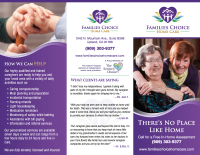
Healthy communication with elderly loved ones must evolve to accommodate age-related changes that pose challenges to hearing, seeing, and remembering.
Patient, connected, and compassionate communication is a cornerstone of building a trusting, loyal, and satisfying relationship between caregivers and clients.
Tips for Improving Communication With Aging Loved Ones
Understanding some of the barriers aging poses to communication is the first step in practicing clear, effective communication with elderly clients or family members.
For example, children who become caregivers for their parents find themselves in a reversed role. This can lead to unintentional tendencies to become condescending, impatient, and frustrated—especially true if caregivers are fatigued and are headed into burnout.
Younger or less experienced caregivers may speak too fast or lack proper education and training on how aging affects communication. Ultimately, the goal is to foster high-quality, respectful relationships.
Foster Healthy Communication Strategies in 6 Steps
Here are six things you can do to create a foundation of healthy communication with aging loved ones and clients, intuitively meeting them where they’re at.
1. Keep on Top of Age-Related Changes That Impact Communication
Routine visits (once a year or more) with general physicians, auditory specialists, optometrists, neurologists, and other specialists are essential for supporting age-related changes affecting an elder’s hearing, sight, and memory.
We also recommend scheduling a pharmacy consultation to review all current medications. You’d be surprised how often signs of memory loss/confusion turn out to be bad reactions from prescription combinations or doses that are greater than necessary. It’s also wise to schedule a consult when a new medication is prescribed or there’s a change in dosage.
2. Ask Questions, But Be Patient
Preserving independence and autonomy are two key reasons 90% of seniors prefer to age-in-place in their homes. However, when well-meaning caregivers assume or tell them what they need and how they feel, they strip independence and autonomy right out of the equation.
Instead of making assumptions or decisions for your loved one, ask them questions and wait patiently for their answers. This keeps them engaged as an active participant in their long-term care plan.
Even if what they want isn’t possible, the information gleaned from listening can help you craft compromises or other solutions which demonstrate that you value their feelings, needs, and wants.
Start with simple things, like asking them what they want for dinner or where they’d like to go on outings this week. Give them time to process and answer. If cognitive decline poses a challenge, offer two or three options so they still have a choice.
Asking questions is a great way to keep their neurons firing in other ways, too—even if that means reflecting more and more into the past. You can ask about:
- Favorite memories
- The things they’re most proud of in their life
- To tell you who everyone is in an old family photo or about mementos in a scrapbook
- Their first date or their first kiss
- The jobs they’ve held in their lifetime
- Things they wish they’d done but hadn’t
- Anything else around their home or in passing conversations that pique your interest about their experiences
Professional caregivers often come into the picture toward the end of a client’s life, so learning more about who they were helps us to connect more fully with clients.
3. Practice Active Listening & Reflection
Active listening skills foster healthy relationships with spouses, children, and colleagues. Practicing active listening means you truly hear what the person is saying—rather than making assumptions or planning a response while they’re still speaking (a common habit).
For a detailed “lesson” on active listening, we recommend reading How to Practice Active Listening from positivepsychology.com. The three principles of active listening are:
- Listening for total meaning.
- Responding to feelings.
- Watching/listening for non-verbal cues (tone/volume of voice, body language, etc.)
It also involves reflecting on what you heard the person say before providing your response: “I heard you say…” Sometimes, you may learn you heard incorrectly OR the client may realize they didn’t say what they meant to say. Your verbatim reflection gives them a chance to reword it. Active listening also allows you to check in when the non-verbal cues don’t match the words.
For example, let’s say you ask, “Would you like to head out to the park today?” The individual responds, “That sounds fine,” but their tone, crossed arms, and averted eyes indicate it doesn’t appeal at all.
Now you can empathetically reflect, “Your words say it’s fine, but I notice your tone and crossed arms indicate otherwise. Is there something else you’d rather do? If so, I’d love to hear your ideas.”
The more you practice active listening, genuinely opening yourself to hearing what people around you are communicating, the more fulfilling your relationships will be.
4. Resist the Temptation to Argue
Most caregivers (outside of spouses) are of a different generation than their loved ones or clients. Differences in life experience and worldview can cause significant contrasts in opinions. However, resist the temptation to argue or change a person’s mind.
If you hear something that challenges your way of thinking or believing, get curious and practice those active listening skills. Learn more about how and why the person has the opinions or beliefs they have…and then let them be. Rather than focusing on the places where you differ, pay attention to the areas where you’re aligned and celebrate those.
5. Slow Down and Minimize Distractions
Technological innovations have created a world that is faster and louder than ever before. This is challenging for most seniors and impairments like hearing loss or cognitive decline increase their need for slower, less distracted interactions.
- During important conversations, eliminate background noise and visual distractions (like the TV).
- Use face-to-face interactions whenever possible, allowing seniors to use other cues like lip movements and facial expressions to better understand what you’re saying.
- Speak clearly and at a reasonable pace (without being condescending or patronizing).
That leads us to the next important tip on how to communicate with elderly loved ones.
6. Do Not “Talk Down,” Condescend, or Patronize
Be aware of yourself and notice whether you’re talking down, condescending, or patronizing an elder. This is often a sign of exhaustion or pending burnout. Patience is the key to ensuring we speak respectfully while remaining as empathetic and curious as often as possible.
Sometimes we accidentally “talk down” to clients in our well-meaning effort to slow down and speak clearly enough to be understood. It’s a fine line, but pay attention to your tone. If it sounds more like you’re talking to a three-year-old than an 83-year-old, it’s time to adjust.
Bonus Tip: Don’t Forget About Humor
Let’s face it: providing home care—including personal care services—has its fair share of challenging moments. Maintaining a light heart and a sense of appropriate humor goes a long way to keeping open lines of communication and connection.
Families Choice Home Care Supports Effective Communication With Elderly Clients
Are you finding it more challenging to communicate with your aging loved one to keep them safe and healthy at home? Then it might be time to schedule a home assessment with Families Choice Home Care.
Request a Free Home Care Assessment
If you want to learn more about the wide range of services we offer—respite care, part-time, and full-time care, just click below. We can also help you learn new communication methods that improve relationships and enhance the quality of life of your elderly loved one.





